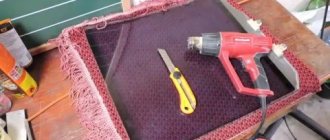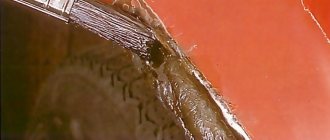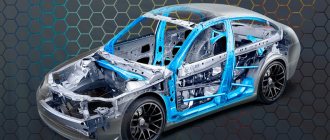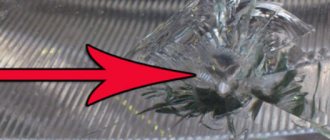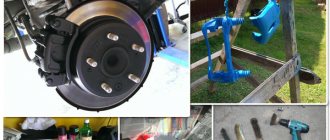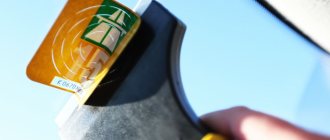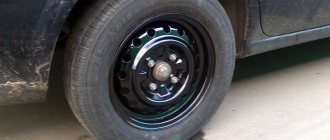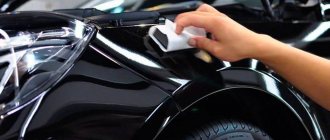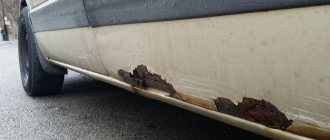Welcome to the kuzov.info blog!
This article will introduce you to various ways to remove paint from a car body.
The paint removal process can be divided into two main categories - mechanical and chemical. The mechanical method involves using some kind of abrasive to remove paint from metal. Abrasives, in turn, range from regular sandpaper to sandblasting.
The most obvious and simple method is to remove the paint by sanding. This method is less expensive, but more labor-intensive.
Removing paint from a car by sanding
You need to start with P80 abrasive. If there are layers of putty under the paint, then you can use a coarser abrasive, up to P40. But you need to be careful, since such a large abrasive easily grinds the metal, making it thinner.
I repeat, if there are no thick layers of putty, then using a grinding wheel with a P80 abrasive grade will be safer for the metal. It removes paint quite well and is not too aggressive on metal.
If the paint layer is very thin and the car has not been repainted many times, then a good option would be to use sanding discs with P180 - P400 abrasive.
When using an orbital sander, you need to set the rotation speed correctly. Too high a speed may heat up the paint. The grinding wheel will become clogged and will need to be replaced prematurely with a new one.
Sanding discs and attachments with aluminum oxide abrasive
These are grinder discs and drill attachments, which are essentially a variation of paper or fabric-based sanding discs designed for use on orbital sanders.
They are quite effective. You need to be careful when using coarse abrasive discs and attachments, as they easily scrape and heat the metal.
Such discs and attachments can be recommended for preparing surfaces for further puttying.
Clean 'N Strip wheels
These discs are made of large silicon carbide fibers (XCS - Extra Coarse Silicon Carbide) and are black in color. There are even more wear-resistant Clean and Strip discs in blue, which have a similar structure, but consist of large nylon threads.
Disc “Clean and Strip”
There are only two options for using these discs - for a drill and for an angle grinder. They are very effective and compare favorably to other paint removal discs. They do not clog or damage the metal. These discs are also suitable for removing rust and welding spatter, sealants and anticorrosion agents. They last for a long time. Clean and Strip discs can be used until they are completely worn out.
After the advent of Clean and Strip abrasive discs, many craftsmen from all over the world appreciated this product and began to use it, replacing other abrasive attachments. Many who have tried using such disks note their high efficiency and speed.
Removing paint from a body using a sandblasting machine
Sandblasting paint removal is very effective. Layers of paint that take many hours to remove by sanding are “evaporated” by sandblasting in minutes.
Sandblasting of the body
Depending on the material used in such processing, as well as the amount of pressure, paint removal can be very gentle, or it can be quite aggressive and capable of removing putty and rust.
If used incorrectly, sandblasting can seriously damage the body. You can make a “hole” in the sheet metal or deform it, since aggressive sandblasting can heat up the metal.
The material for the sandblaster should be selected in accordance with what is under the top layer of paintwork. If there is not a lot of putty or rust underneath the paint, or if you are removing paint from a fiberglass or plastic surface, then baking soda will work.
Aluminum oxide is suitable for cleaning rust or large amounts of putty.
Before sandblasting, you need to cover areas where you do not want contact with abrasives.
If you are going to use the sandblasting service, then the cost is affected by how ready the car is for the procedure. It is better to disassemble the car to the required condition in advance.
Let's sum it up
Working with paint and varnish is a rather complex and delicate process, no matter what procedures we are talking about. Therefore, it is extremely important to perform high-quality paint restoration and get really good opportunities for implementing certain body restoration processes. You can independently eliminate the consequences of paint getting on the body of your car, but in this case you are exposed to a certain risk. The complexity of the damage should be assessed in order to completely neutralize the consequences and prevent the destruction of the paintwork on your car.
If you have doubts that you can do everything yourself with sufficient quality, use the help of specialists. Today, many companies offer services for restoring or updating paintwork on cars. It is in these service centers that you can get qualified paint processing services on your car. Specialists in such companies have high-quality tools and know effective effective techniques for working with various paint damage on cars. What method would you choose if you needed to remove someone else's paint from a car?
Chemical paint remover
Chemical paint remover
Paint remover is applied with a brush and an aerosol can. It is sold in liquid or gel form. Usually two cans are enough to treat the entire medium-sized body. Depending on the type of paint and its thickness, the remover lasts from 10 minutes to an hour. The paint will begin to bubble and peel. You need to wait the sufficient amount of time specified in the instructions. The paint should soften.
After exposure to the remover, the paint can be scraped off with a spatula.
After removing the peeling paint, the chemical elements of the remover continue to act. Before priming, you need to wash, sand and degrease the surface to neutralize any remaining remover. You need to pay attention to the seams and joints, since the remover is not easy to remove from there. Before applying the remover, it is better to seal these places and then clean them mechanically.
Do not apply the remover on a hot day. It will dry out before it does its job. But you can use one method that will prevent the paint remover from quickly evaporating. After treatment with paint remover, you can cover the body with plastic film. When using this method, the process of exposure of the paint to the chemical composition will proceed faster.
At low temperatures, the remover acts slowly. Thus, it is better to use this remedy at room temperature.
Depending on the thickness of the paint layer, after exposure to the product and scraping, some of the paint may remain. Washing off the paint usually removes the top layer and, if the body or individual parts have been repainted many times, then, in this case, you need to repeat the application of the wash and subsequent scraping.
You can also remove paint using a metal sponge. Small residues can be easily removed with Scotchbrite.
When removing paint in hard-to-reach places, you can use a wire brush. Do not use wire attachments on your drill. After chemically removing paint, it is safer to remove peeling paint by hand. This way, paint soaked in remover and chemical residues will not fly around.
Chemical remover contains toxic substances that are hazardous to health. Skin and eyes must be protected by wearing protective gloves and goggles, and there must be good ventilation in the workshop where it is used. If there is no active ventilation, then you need to keep the door open.
General recommendations on how to erase paint
Removing foreign paint from a car is a painstaking task that requires utmost care. An incorrect movement or the wrong product can remove the varnish from your body. To avoid unpleasant surprises, follow these rules.
- A thick layer of paint can be removed with a plastic spatula. You must act carefully so as not to damage the top coating.
- Before using an aggressive product that is dangerous for body paint, be sure to check its effect on the paint on the inside of the car (for example, under the hood). If the color of the paint changes, the product must either be diluted with water to reduce the concentration of active substances or replaced with a more gentle one.
- Despite the preliminary test on the “rough” area of the body, it is necessary to periodically check the effect of the product on the varnish. If you see that the surface is losing its shine, you should abandon this method.
- When working with chemical solvents, follow all safety precautions. Do not allow the substance to come into contact with your skin or mucous membranes, as this may be harmful to your health.
- Make sure that the solvent does not come into contact with rubber or plastic parts of the car. An aggressive composition can ruin them.
- When trying to remove paint from a body, it is very easy to damage the top layer of varnish. A polish can correct the situation.
- If the methods described above do not help, you should contact a specialized service center. Specialists will be able to choose the most suitable remedy depending on the severity of the damage.
Dipping
This method is unlikely to be suitable for use in garage conditions, but it is worth mentioning. The dipping takes place in a giant tank of acid. Hydrochloric acid is usually used. This method is used by professional restorers. There are various formulas that remove paint and attack rust.
This method is quite expensive, as it requires complete disassembly of the car and the presence of a huge container of acid. In essence, a completely disassembled body is dipped. Removable body panels are dipped separately.
When dipped in acid, it gets into all the joints of the body and remains there. This can become a problem during further priming and painting. Therefore, after dipping, further pressure washing and blowing of the body is required. “Bare” metal quickly oxidizes, so after all procedures, the body should be coated with primary acid primer.
What should be the preparatory process?
For safety, remove all external accessories from your car; The sandblasting process removes chrome as well as paint, making it very easy to remove glass and any mirrored surface.
It is best to remove all vulnerable parts of the car or cover them with a fairly thick material. You may want to test your chosen material first to make sure the sandblaster won't penetrate it.
Manufacturers and suppliers of sandblasting equipment usually provide their products with diagrams that can help you determine the relationship between pressure and type of filler you need for certain tasks.
The filler is assessed according to the size of its grains of sand - the lower the number, the smaller the grain of sand.
For use on parts and surfaces of the car body, the acceptable range of numbers is from 40 (0.4 mm.) to 12 (0.1 mm.).
The filler also contains mixtures that combine different amounts of sand grains of different sizes. If you are unsure about the filler that is right for you, consult your sandblasting dealer or auto paint store.
The size of the filler and the pressure at which it is ejected are key factors in the entire sandblasting process.
Be sure to set the correct pressure or you will cause unnecessary deformation to the car body.
You will also need to think about your own protection from the sand ejected from the sandblaster. Therefore, you will need to wear thick gloves, long sleeves and a high-quality protective hoodie.
It's also a good idea to wear a quality respirator, preferably NIOSH-approved. The crushed filler will generate dust that is harmful to the respiratory system. You can buy a respirator, gloves, sandblaster and filler at many large auto painting equipment stores.
Equipment such as a home-use sandblaster that draws fill from a bucket can cost as little as $40 to more than $400 for high-end models.
A variety of exhaust ports require air compressors with the appropriate power, so on site, carefully study the diagrams included with them to select the correct exhaust port size; The fill and air pressure you use should be applicable to your current task.
Removing body paint with dry ice
This method is quite new, but is quickly spreading and becoming popular all over the world. Removing paint with dry ice requires special equipment.
This method is similar to sandblasting. The equipment operates from a source of compressed air, but instead of abrasive particles, dry ice particles are used, which, when colliding with a surface, “explode” and destroy the paint layer.
Here are some benefits of dry ice paint removal:
- Non-abrasive effect on the surface. The metal or any other material from which the paintwork is removed is not damaged at all.
- Completely environmentally friendly method. The environment is not polluted and there is no danger to health. A similar method is used even in the food industry.
- Adjacent body parts are not damaged.
- After exposure, there are no product residues on the surface that require subsequent rinsing and blowing, as is the case with sandblasting.
- For all its delicacy, the method is very effective in removing paintwork.

